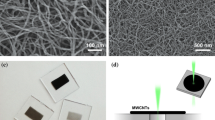Abstract
In this paper, some optical properties of a two-walled carbon nanotube are studied. The system is represented by two infinitely long and infinitesimally thin coaxial cylindrical shells, each containing a two-dimensional electron nano-fluid. The quasi-static approximation and the quantum hydrodynamic model are adopted in order to obtain the optical response of the system. General expressions for polarizability, dispersion of dipole surface plasmons and induced surface charges of the system are derived, by solving the Laplace and fluid equations with appropriate boundary conditions. Also, by using the polarizability formula, scattering, absorption and extinction spectra are computed and expressed in terms of widths, which are defined as the cross sections per unit length of the system. Furthermore, the Maxwell-Garnett theory for the effective medium approximation of composite materials is developed to the effective dielectric function of a composite of aligned two-walled carbon nanotubes.







Similar content being viewed by others
References
S. Iijima, Nature 354, 56 (1991)
R. Kuzuo, M. Terauchi, M. Tanaka, Jpn. J. Appl. Phys. 31, L1484 (1992)
T. Pichler, M. Knupfer, M.S. Golden, J. Fink, A. Rinzler, R.E. Smalley, Phys. Rev. Lett. 80, 4729 (1998)
P. Longe, S.M. Bose, Phys. Rev. B 48, 18239 (1993)
C. Yannouleas, E.N. Bogachek, U. Landman, Phys. Rev. B 53, 10225 (1996)
M.R. Eid, A.F. Al-Hossainy, M.S. Zoromba, Commun. Theor. Phys. 71, 1425 (2019)
A. Gallerati, Eur. Phys. J. Plus 134, 202 (2019)
T. Stockli, J.M. Bonard, A. Chatelain, Z.L. Wang, P. Stadelmann, Phys. Rev. B 64, 115424 (2001)
Y.N. Wang, Z.L. Miskovic, Phys. Rev. A 69, 022901 (2004)
A. Moradi, JETP Lett. 88, 795 (2008)
A. Moradi, Problems in electrostatic approximation, in Canonical Problems in the Theory of Plasmonics (Springer Series in Optical Sciences, Springer, Switzerland, Cham, 2020), vol. 230
A. Moradi, Photon. Nanostruct. Fundam. Appl. 11, 85 (2013)
A. Moradi, Appl. Phys. A 113, 97 (2013)
A. Moradi, Phys. Plasmas 17, 033504 (2010)
A. Moradi, Phys. Plasmas 21, 032106 (2014)
A. Moradi, J. Appl. Phys. 122, 133103 (2017)
I. Maeng, C. Kang, S.J. Oh, J.H. Son, K.H. An, Y.H. Lee, Appl. Phys. Lett. 90, 051914 (2007)
M.V. Shuba, G.Y. Slepyan, S.A. Maksimenko, C. Thomsen, A. Lakhtakia, Phys. Rev. B 79, 155403 (2009)
T. Muhammad, D.C. Lu, B. Mahanthesh, M.R. Eid, M. Ramzan, A. Dar, Commun. Theor. Phys. 70, 361 (2018)
A.A. Green, M.C. Hersam, ACS Nano 5, 1459 (2011)
Z.K. Heiba, M.B. Mohamed, N.G. Imam, A.M. El-Naggar, J. Supercond. Nov. Magn. 33, 1439 (2020)
C.Q. Ru, J. Mech. Phys. Solids 49, 1265 (2001)
X.Q. He, M. Eisenberger, K.M. Liew, J. Appl. Phys. 100, 124317 (2006)
M. Strozzi, F. Pellicano, Math. Mech. Solids 23, 1456 (2018)
B.E. Sernelius, Van der waals interaction in cylindrical structures, in Fundamentals of van der Waals and Casimir Interactions (Springer Series on Atomic, Optical, and Plasma Physics, Springer, Switzerland, Cham, 2018), vol. 102
G. Gumbs, A. Balassis, P. Fekete, Phys. Rev. B 73, 075411 (2006)
D.J. Mowbray, S. Chung, Z.L. Miskovic, F.O. Goodman, Y.N. Wang, Nucl. Instrum. Methods Phys. Res. B 230, 142 (2005)
A. Moradi, Phys. Plasmas 22, 032112 (2015)
L. Calliari, S. Fanchenko, M. Filippi, Carbon 45, 1410 (2007)
S. Tasaki, K. Maekawa, T. Yamabe, Phys. Rev. B 57, 9301 (1998)
D.J. Mowbray, S. Segui, J. Gervasoni, Z.L. Miskovic, N.R. Arista, Phys. Rev. B 82, 035405 (2010)
C. Rizal, V. Belotelov, Eur. Phys. J. Plus 134, 435 (2019)
A. Moradi, J. Opt. Soc. Am. B 29, 625 (2012)
E. Prodan, C. Radloff, N.J. Halas, P. Nordlander, Science 302, 419 (2003)
A.F. Al-Hossainy, M.R. Eid, M.S. Zoromba, Phys. Scr. 94, 105208 (2019)
A.F. Al-Hossainy, M.R. Eid, M.S. Zoromba, Mater. Chem. Phys. 232, 180 (2019)
A.F. Al-Hossainy, M.R. Eid, M.S. Zoromba, J. Electr. Mater. 48, 8107 (2019)
R. Chang, H.-P. Chiang, P.T. Leung, D.P. Tsai, W.S. Tse, Solid State Commun. 133, 315 (2005)
J.T. Manassah, Phys. Rev. A 88, 035803 (2013)
F.F. Chen, Introduction to Plasma Physics and Controlled Fusion (Plenum, New York, 1984)
G.B. Smith, J. Phys. D: Appl. Phys. 10, L39 (1977)
Author information
Authors and Affiliations
Corresponding author
Appendix: An alternative derivation of effective permittivity of a composite of aligned 2WCNTs
Appendix: An alternative derivation of effective permittivity of a composite of aligned 2WCNTs
In this alternative approach, we consider a 2WCNT plus surrounding dielectric shell (here, air) placed in the effective medium. The effective dielectric permittivity of the system \(\varepsilon _{\mathrm {eff}}\) can be determined by requiring that this 2WCNT produce no perturbation of the electric field in the surrounding medium [41]. Therefore, the system to be studied is a 2WCNT with external radius \(a_{2}\) that is enclosed within a dielectric cylinder of radius \(a_{3}\). The volume between \(a_{2}\) and \(a_{3}\) represents the average envelope per particle and \(f=a_{2}^{2}/a_{3}^{2}\). In this regard, we assume the new system, i.e., a coated 2WCNT embedded in an effective medium having a dielectric constant \(\varepsilon _{\mathrm {eff}}\), is illuminated by a uniform, quasi-static electric field as discussed in the section of Basic theory. In this case, we have
The coefficients \(\mathcal {A}_{1}-\mathcal {F}_{1}\) in Eq. (A-1) can be determined from the matching boundary conditions of the potentials at the surfaces \(\rho =a_{1}\), \(\rho =a_{2}\), and \(\rho =a_{3}\). By matching the boundary conditions on the interface of the air shell and effective medium, i.e., \(\rho =a_{3}\), one obtains
Using the condition \(\mathcal {F}_{1}=0\) for the present system [41], from Eq. (A-2) can be concluded
To determine the unknown coefficients \(\mathcal {D}_{1}\) and \(\mathcal {E}_{1}\), the boundary conditions, i.e., Eqs. (4)–(7), must be enforced at \(\rho =a_{1}\) and \(\rho =a_{2}\), that yield
Finally, by substituting Eq. (A-4) into Eq. (A-3), Eq. (29) can be derived.
Rights and permissions
About this article
Cite this article
Moradi, A. Optical properties of two-walled carbon nanotubes: quasi-static approximation. Eur. Phys. J. Plus 135, 611 (2020). https://doi.org/10.1140/epjp/s13360-020-00621-3
Received:
Accepted:
Published:
DOI: https://doi.org/10.1140/epjp/s13360-020-00621-3




